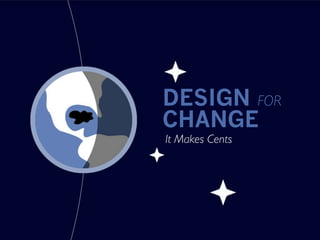Design for Change, It Makes Cents
- 1. DESIGN FOR CHANGE It Makes Cents
- 2. HELLO. IŌĆÖM PATRICK. and IŌĆÖm not a sausage.
- 5. CHANGE
- 7. CHANGING THE WORLD IS ABOUT MORE THAN JUST BEING GREEN
- 8. ŌĆ£TO MAKE THE FORM, NATURE, CONTENT, FUTURE COURSE, ETC., OF (SOMETHING) DIFFERENT FROM WHAT IT IS OR FROM WHAT IT WOULD BE IF LEFT ALONEŌĆØ - dictionary.com
- 11. THE 50 CENT POPE COIN CHANGE WE CAN BELIEVE IN
- 12. WHY DO WE NEED IT? Because bad design sucks.
- 27. WHY CHANGE? For our users (and for pro’¼üt too).
- 30. THE THING I HATE THE MOST ABOUT ADVERTISING IS THAT IT ATTRACTS ALL THE BRIGHT, CREATIVE AND AMBITIOUS YOUNG PEOPLE, LEAVING US MAINLY WITH THE SLOW AND SELF-OBSESSED TO BECOME OUR ARTISTS. -Bansky
- 31. 1. PEOPLE ARE LAZY They just donŌĆÖt ŌĆ£feelŌĆØ like it.
- 36. REDUCE SIGN-UP FRICTION Let your users get to work
- 38. ŌĆ£USERS DONŌĆÖT WANT TO USE YOUR FORM. THEY WANT WHATŌĆÖS ON THE OTHER SIDE.ŌĆØ - Luke Wroblewski
- 51. 2. PEOPLE HAVE HABITS And theyŌĆÖre used to them, good or not.
- 58. 3. PEOPLE ARE WARY They donŌĆÖt trust you or your web form.
- 59. ŌĆ£I GET SO IMPRESSED WHEN I CLICK ŌĆśUNSUBSCRIBEŌĆÖ IN EMAILS AND IT WORKS THAT I ALMOST WANT TO RE-SUBSCRIBE.ŌĆØ - Fred LeBlanc @fredleblanc
- 60. DONŌĆÖT DECEIVE They WILL ’¼ünd out.
- 66. 4. PEOPLE GET DISTRACTED Oooh! Something shiny!
- 71. 1. CREATE CHANGE AT WORK Even if you donŌĆÖt have permission
- 76. <DIV ID=ŌĆØBLOGŌĆØ> <DIV CLASS=ŌĆØHENTRYŌĆØ> <H3 CLASS=ŌĆØENTRY-TITLEŌĆØ>ABOUT THE SCHOOL OF PUBLIC HEALTH</H3> <P CLASS=ŌĆØENTRY-CONTENTŌĆØ>LOREM IPSUM...</P> </DIV> </DIV>
- 77. 2. CHANGE YOUR TOOLS Make them better for you and others.
- 81. DO WEBSITES NEED TO BE EXPERIENCED EXACTLY THE SAME IN EVERY BROWSER?
- 86. 3. MAKE CHANGE ON THE SIDE Personal projects are more personal.
- 91. <P> THE PAGE YOU REQUESTED COULD NOT BE FOUND BUT PERHAPS YOU CAN HELP FIND A MISSING CHILD: </P> <SCRIPT TYPE="TEXT/JAVASCRIPT" CHARSET="UTF-8" SRC=/slideshow/design-for-change-it-makes-cents/6040773/"HTTP:/ SCRIPT.MISSINGCHILDREN404.ORG/SCRIPT.JS"> </SCRIPT>
- 94. 4. CHANGE THE WORLD One person at a time.
- 98. Text ŌĆ£notasausageŌĆØ to 50500
- 105. <SCRIPT LANGUAGE="JAVASCRIPT" TYPE="TEXT/JAVASCRIPT" SRC=/slideshow/design-for-change-it-makes-cents/6040773/"HTTP:/WWW.ONLINELEAF.COM/ SAVETHEENVIRONMENT.JS"></SCRIPT>
- 106. OUR USERS Are lazy, so make it easy. Have habits, so take advantage. Are wary, so earn their trust. Get distracted, so keep them focused.
- 107. MAKE A CHANGE Create change at work, even if it isnŌĆÖt approved. Help change the tools you use. Use side projects to do good. Be a ŌĆ£greenŌĆØ designer.
- 108. THANK YOU. Patrick Haney Designer/Developer at Hanerino, Inc. @notasausage http://hanerino.com
- 109. QUESTIONS?
- 110. CHANGE THIS PRESENTATION Give your feedback, and make it better http://spkr8.com/t/5187














































































































